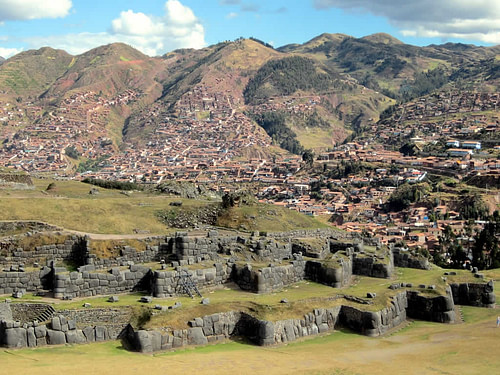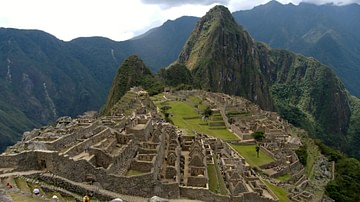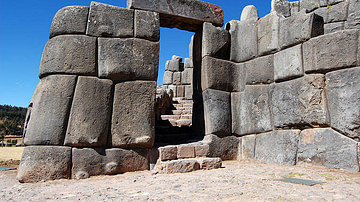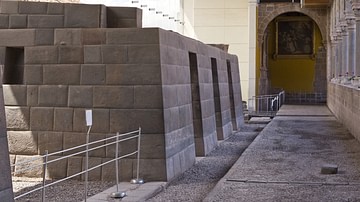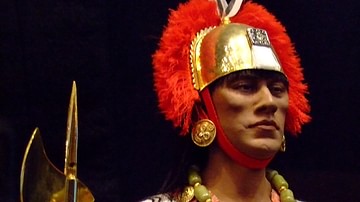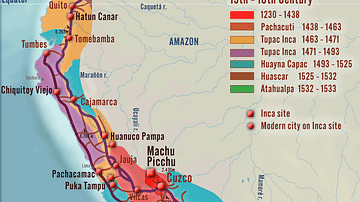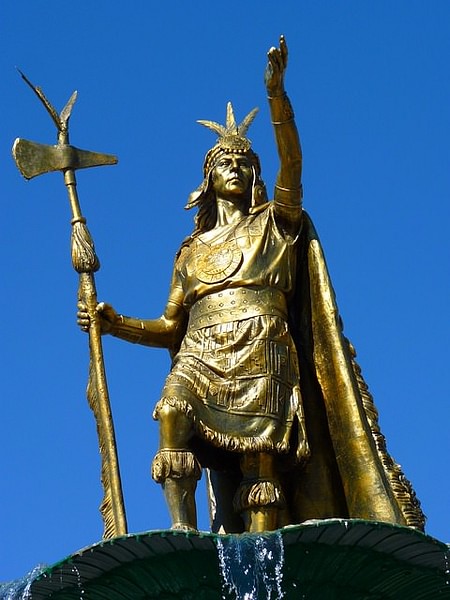
Pachacuti Inca Yupanqui (often simply Pachacuti or Pachacutec) was the 9th Inca ruler (r. 1438 - 1471 CE) who founded their empire with conquests in the Cuzco Valley and beyond. Pachacuti is also credited with founding the site of Machu Picchu.
The Inca ruler's title Pachacuti, which he gave himself on his accession, means 'Reverser of the World' or 'Earth-shaker,' and the same word was used by the Incas to refer to the epoch-changing event or 'turning over of time and space' which they believed occurred regularly through history. An appropriate enough title, then, for a ruler who set his people on the road to prosperity and the creation of an empire which would eventually be the largest ever seen in the Americas.
Rise to Power
According to the semi-legendary early history of the Incas, Pachacuti rose to prominence when their war-like neighbours, the Chanca, attacked Cuzco in the early 15th century CE. The Inca ruler at the time, Viracocha Inca, and his son Inca Urco proved ineffectual in meeting this threat and fled the city. The young prince Pachacuti (known then as Cusi Yupanki) and a small band of loyal warriors, inspired by a vision of a shining tablet sent by the Sun god Inti, decided to stay and make a stand. Still, things looked desperate and Pachacuti called on the gods to help him more than sending messages of support. This they did by transforming rocks laying about the place into Inca warriors. With this army, Pachacuti kicked the Chanca out of Cuzco. In thanks for this divine help the leader set up the stone warriors (Pururaucas) in sacred shrines around the city.
Building An Empire
Pachacuti was the first Inca ruler to have ambitions beyond Cuzco, and he conquered territories in the Cuzco (Huantanay) Valley and beyond, thus beginning the Inca empire which would grow and last until the Spanish conquest from 1532 CE. First, all speakers of the Inca language, Quechua, were given citizenship, a privileged status they would enjoy over all conquered peoples and which gave them the right to hold all important government and administrative offices.
Moving south-east Pachacuti then conquered the basin of Lake Titicaca, including the cultures of the Colla and Lupaqa. Pachacuti then retired to Cuzco while his brothers and son, Tupac Inca Yupanqui (with whom he may have co-ruled), were given the task of continuing the conquest of the Andes, perhaps making their first incursions south into Ecuador and the Chimu civilization. Concentrating on government Pachacuti is credited with introducing the various apparatus of state which would ensure the Incas could continue their regional domination long-term.
Government & Cuzco
The Inca ruler (Sapa) introduced systems of tribute and taxation which were paid by conquered peoples either in the form of goods or labour. These made the Incas unpopular but they were used productively to create an extensive road network linking towns and sacred sites. A system of storage houses (qollqa) were also built and dotted around the empire to ensure a plentiful food supply even in times of low agricultural yield. In an effort to simplify royal succession, Pachacuti instigated the system of a ruler nominating his principal wife from whom heirs to the throne would be drawn. Pachacuti had historians record the important episodes of Inca history on painted tablets, which were then stored for posterity in a building at the capital where no one without authorization might enter. Finally, he fixed the calendar of market days and public holidays.
With his conquests and income made more secure, Pachacuti, perhaps following an inspirational visit to monumental Tiwanaku, then set about aggrandising his capital and replacing its many earthen structures with impressively crafted stonework. He drained the northern area of Cuzco and built there a new ceremonial centre and built himself a palace known as Kunturkancha. He also rebuilt the Temple of Inti in the Coricancha complex and started construction of the fortress-like Sacsayhuaman which would protect the northern approach to Cuzco. Pachacuti built city-temple-fortress sites at other strategically important locations such as Pisac and Ollantaytambo at either end of the Urubamba Valley and many way-stations in the outposts of the empire such as Tambo Colorado on the coast.
Machu Picchu
Pachacuti Inca Yupanqui probably founded Machu Picchu (meaning 'old hill') c. 1450 CE. The purpose of the site is not agreed upon by scholars and may have been a fortress, imperial retreat, a symbol of Inca power for the benefit of conquered locals, or a ceremonial precinct. Perhaps the most likely role was the latter as most of the architecture was designed for religious purposes, and the site's fortifications may well have been put in place to ensure only a select few could enter this sacred site. In further support of this interpretation, a road was discovered which linked the site to several residential settlements dotted along the valley. The town had capacity for around 1,000 residents at its peak and ranked amongst the most sacred of all sites for the Inca. On the ruler's death the ownership of the site passed to Pachacuti's family successors. The site was abandoned by the Inca shortly before Pizarro and the Spanish conquistadors arrived in South America, who never stumbled across it.
Death & Burial
The Inca ruler died in 1471 CE and, according to his wishes, the Incas mourned for one whole year. They then held a month-long celebration of their great leader during which his personal items were paraded around the corners of the empire, a mock battle was staged at Cuzco, and 2,000 llamas were sacrificed. A thousand more llamas were sacrificed around the empire and, so too, children were sacrificed in all the places that the ruler had visited in his lifetime.
Pachacuti was mummified and may have been buried in a shrine known as Patallacta at Kenko (Q'enqo') on the heights above Cuzco. Even after death, the ruler continued to be venerated and his mummy (mallki), along with other past rulers, was regularly given outings into the outside world where it was ritually fed and even, on occasion, 'consulted' in times of political strife. In addition, the Inca's hair and fingernails were incorporated into a sacred statue of him, and Pachacuti's large stone hunting lodge at Tambo Machay, just above Cuzco, was made into a sacred site or huaca. In the official Inca state archives, such were his stature and achievements, that almost all significant developments in statecraft and empire were credited to Pachacuti.

Tupac Inca Yupanqui took over as Sapa Inca and continued his father's imperial plans, eventually doubling the size of the empire. In 1559 CE the Spanish discovered Pachacuti's mummy, which had been secretly hidden by the Incas following the conquest. It was sent to Lima by Juan Polo de Ondegardo but was lost in transit or perhaps simply destroyed like so many other symbols of Inca culture.
